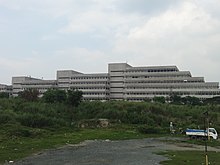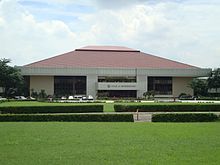Congress of the Philippines Kongreso ng Pilipinas (Filipino) | |
|---|---|
| 19th Congress of the Philippines | |
  Seals of the Senate (left) and of the House of Representatives (right) | |
| Type | |
| Type | |
| Houses | Senate House of Representatives |
| History | |
| Founded | June 9, 1945 |
| Preceded by | National Assembly of the Philippines |
New session started | July 25, 2022 |
| Leadership | |
| Structure | |
| Seats | 340 (see list) 24 senators 316 representatives |
 | |
Senate political groups |
|
 | |
House of Representatives political groups | |
Joint committees | Joint committees are chaired by senators |
| Authority | Article VI of the Constitution of the Philippines |
| Elections | |
| Multiple non-transferable vote | |
| Parallel voting (Party-list proportional representation and first-past-the-post) | |
Last Senate election | May 9, 2022 |
Last House of Representatives election | May 9, 2022 |
Next Senate election | May 12, 2025 |
Next House of Representatives election | May 12, 2025 |
| Meeting place | |
 | |
| The Senate meets at the GSIS Building, Financial Center, Jose W. Diokno Boulevard, Pasay | |
 | |
| The House of Representatives meets at the Batasang Pambansa Complex, Quezon City, which also hosts joint sessions | |
| Website | |
| econgress | |
The Congress of the Philippines (Filipino: Kongreso ng Pilipinas) is the legislature of the national government of the Philippines. It is bicameral, composed of an upper body, the Senate, and a lower body, the House of Representatives,[3] although colloquially, the term "Congress" commonly refers to just the latter.[b] The Senate meets at the GSIS Building in Pasay, while the House of Representatives meets at the Batasang Pambansa in Quezon City, which also hosts joint sessions.
The Senate is composed of 24 senators[4] half of which are elected every three years. Each senator, therefore, serves a total of six years. The senators are elected at-large and do not represent any geographical district.
In the current 19th Congress, there are 316 seats in the House of Representatives. The Constitution states that the House "shall be composed of not more than 250 members, unless otherwise fixed by law", and that at least 20% of it shall be sectoral representatives. There are two types of congressmen: the district and party-list representatives. At the time of the ratification of the constitution, there were 200 districts, leaving 50 seats for party-list representatives.
The district congressmen represent a particular congressional district of the country. All provinces in the country are composed of at least one congressional district. Several cities also have their own congressional districts, with some having two or more representatives.[3] From 200 districts in 1987, the number of districts have increased to 253.[5] Every new Congress has seen an increase in the number of districts.
The party-list congressmen represent the minority sectors of the population. This enables these minority groups to be represented in the Congress, when they would otherwise not be represented properly through district representation. Party-list representatives represent labor unions, rights groups, and other organizations.[3] With the increase of districts also means that the seats for party-list representatives increase as well, as the 1:4 ratio has to be respected.
The Constitution provides that Congress shall convene for its regular session every year beginning on the 4th Monday of July. A regular session can last until thirty days before the opening of its next regular session in the succeeding year. The president may, however, call special sessions which are usually held between regular legislative sessions to handle emergencies or urgent matters.[3]
- ^ Villaruel, Jauhn Etienne (May 20, 2024). "Escudero takes Senate helm after Zubiri resignation". ABS-CBN News. Retrieved May 25, 2024.
- ^ Panti, Llanesca T. "House elects Romualdez as speaker". GMA News. Retrieved July 27, 2022.
- ^ a b c d "Article VI: THE LEGISLATIVE DEPARTMENT". Philippines Official Gazette. Retrieved May 31, 2013.
- ^ "The Legislative Branch". Philippines Official Gazette. Archived from the original on April 7, 2023. Retrieved May 31, 2013.
- ^ Bueza, Michael (June 24, 2021). "LIST: New congressional districts in the 2022 elections". Rappler. Retrieved December 19, 2023.
Cite error: There are <ref group=lower-alpha> tags or {{efn}} templates on this page, but the references will not show without a {{reflist|group=lower-alpha}} template or {{notelist}} template (see the help page).